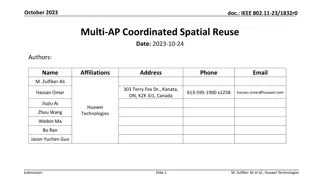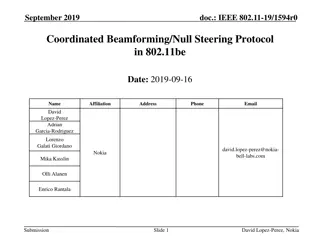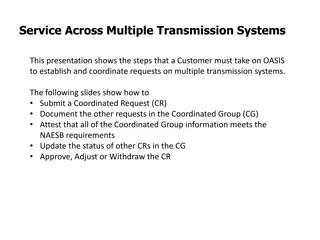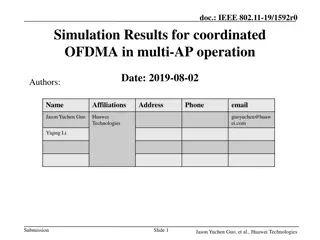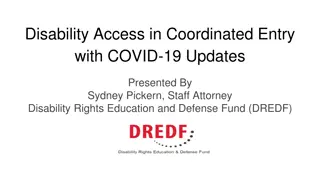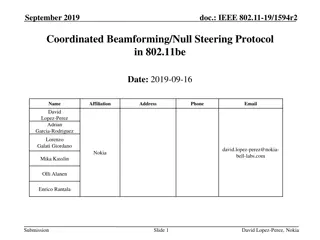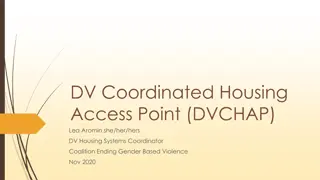
Framework for Coordinated Access Points in IEEE 802.11-24
Explore the framework for Coordinated Access Points (C-AP) in IEEE 802.11-24, focusing on features like C-SR, C-BF, C-rTWT, and C-TDMA to enhance latency and throughput. The presentation delves into a general framework covering capability advertisement, feature-specific negotiations, and container for C-AP information.
Download Presentation

Please find below an Image/Link to download the presentation.
The content on the website is provided AS IS for your information and personal use only. It may not be sold, licensed, or shared on other websites without obtaining consent from the author. If you encounter any issues during the download, it is possible that the publisher has removed the file from their server.
You are allowed to download the files provided on this website for personal or commercial use, subject to the condition that they are used lawfully. All files are the property of their respective owners.
The content on the website is provided AS IS for your information and personal use only. It may not be sold, licensed, or shared on other websites without obtaining consent from the author.
E N D
Presentation Transcript
Aug. 2024 doc.: IEEE 802.11-24/1220 A Framework for Coordinated Access Points Date: 2024-08-19 Authors: Name Affiliations Address Phone email Giovanni Chisci Qualcomm Technologies Inc. 5665 Morehouse Dr., San Diego CA 92121 gchisci@qti.qualcomm.com Abhishek Patil Gaurang Naik Alfred Asterjadhi George Cherian Duncan Ho Sherief Helwa Sanket Kalamkar Submission Slide 1 Giovanni Chisci et Al., Qualcomm
Aug. 2024 doc.: IEEE 802.11-24/1220 Introduction Coordinated APs (C-AP) features are discussed for 11bn to improve latency and throughput and include coordinated spatial reuse (C-SR), coordinated beamforming (C-BF), coordinated rTWT (C-rTWT), coordinated TDMA (C-TDMA), etc. This presentation discusses a general framework for Coordinated APs: C-AP general framework Capability advertisement Per-feature negotiations Container for C-AP information Examples: negotiations and frame exchanges for some C-AP features Submission Slide 2 Giovanni Chisci et Al., Qualcomm
Aug. 2024 doc.: IEEE 802.11-24/1220 General framework Consider the set of C-AP features in 11bn (e.g., C-SR, C-BF, CrTWT, C-TDMA) Phase 1 (Advertisement): A lightweight advertisement of capabilities for the set of supported C-AP features in 11bn No session/agreement establishment at this level (only advertisement) An AP can transmit this frame at will, eventually updating capabilities/parameters for C-AP features Management frames are used Phase 2 (Feature-specific negotiations): When a neighboring AP(s) with capability of a desired C-AP feature is discovered (e.g., after receiving the advertisement of Phase 1), negotiations can be carried out to establish a feature-specific agreement or update its parameters. Agreement is feature-specific (e.g., CrTWT/CTDMA/CBF/CSR agreement) Agreement (and associated messaging) is between a pair of APs Individually addressed Management frames are used Can include negotiation steps Negotiations can be optional/mandatory based on the specific C-AP feature If performed, at least agree on the intention to participate in the feature (request/accept/reject) If performed, may additionally agree on feature-specific parameters (via dedicated elements/subelements) Phase 3 (Feature-specific frame exchange) May or may not include more inter-AP communications depending on the feature E.g., for C-TDMA/C-BF/C-SR inter-AP frames specific to the feature may be exchanged for the operation (e.g., during a TXOP) E.g., for CrTWT, no inter-APs frame exchange during the operation AP BSS2 AP BSS1 Phase 1: capability exchange (management frames) Phase 2: Feature-specific negotiation (inter-AP individually addressed management frames) Phase 3: Feature-specific frame exchange Submission Slide 3 Giovanni Chisci et Al., Qualcomm
Aug. 2024 doc.: IEEE 802.11-24/1220 Example: CrTWT Negotiation and Frame Exchange Reuse the structure of 11be rTWT (based on B-TWT agreements) Phase 2 (Negotiation): Individually addressed management frames to negotiate a CrTWT agreement Negotiation is optional and can start after an AP discovers another capable AP Negotiation includes at least a request message containing the schedule to be protected and a response accept/reject The reference to the CrTWT agreement is the tuple {CrTWT ID, Requesting AP s MAC ID} Note: in 11be rTWT an agreement is referred to via the tuple {B-TWT ID, Scheduling AP s MAC ID} Phase 3 (Utilization): APs engaging in CrTWT perform the following: Owner AP: rTWT Information element with Broadcast TWT information with Broadcast TWT ID If the AP carries out negotiations with other APs, it should consistently use the B-TWT ID used for broadcasting the rTWT schedule in its own BSS as the value for the CrTWT ID used to obtain the agreement with the OBSS AP Non-owner AP: rTWT Information element with Broadcast TWT information with Broadcast TWT ID = 31 and Restricted TWT Schedule Information subfield set to 3 Note: can be used to signal to the non-owner AP s clients that it is an OBSS rTWT schedule Note: this is possible even if there is no formal CrTWT agreement between the APs Slide 4 Submission Giovanni Chisci et Al., Qualcomm
Aug. 2024 doc.: IEEE 802.11-24/1220 Example: CrTWT Negotiation and Frame Exchange AP BSS2 STA BSS2 STA BSS1 AP BSS1 C-AP Advertisement Phase 1 C-AP Advertisement CrTWT Request e.g., for a new agreement with CrTWT ID* Phase 2 CrTWT Response e.g., Accept agreement for the schedule in the Request frame rTWT Announcement over beacon (as in 11be rTWT) B-TWT ID = CrTWT ID* Phase 3 (OBSS) rTWT Announcement over beacon (e.g., as in 11be rTWT, with B-TWT ID = 31) CrTWT Request e.g., update SP parameters for CrTWT ID* Phase 2 CrTWT Response e.g., Reject the new parameters and tear down the agreement Submission Slide 5 Giovanni Chisci et Al., Qualcomm
Aug. 2024 doc.: IEEE 802.11-24/1220 Example: C-TDMA Negotiation and Frame Exchange Phase 2 (Negotiation): Individually addressed management frames to negotiate a C-TDMA agreement Negotiation can start after an AP discovers another capable AP Negotiation (if performed) includes at least a request message and an accept/reject message to establish the intention of sharing the TXOP Other parameters characterizing the traffic for which the TXOPs can be shared can also be negotiated Phase 3 (Utilization): APs can exchange frames at the TXOP granularity Submission Slide 6 Giovanni Chisci et Al., Qualcomm
Aug. 2024 Example: C- TDMA Negotiation and Frame Exchange doc.: IEEE 802.11-24/1220 AP BSS2 AP BSS1 C-AP Advertisement Phase 1 C-AP Advertisement C-TDMA Request e.g., for a new agreement between the 2 APs Phase 2 C-TDMA Response e.g., Accept agreement for the TXOP sharing TXOP level frame exchange Phase 3 C-TDMA Request e.g., update parameters Phase 2 C-TDMA Response e.g., Reject the new parameters and tear down the agreement Submission Slide 7 Giovanni Chisci et Al., Qualcomm
Aug. 2024 doc.: IEEE 802.11-24/1220 Containers for C-AP Information New Public Action frames can be used Appealing because they can be sent in unassociated state (clause 11.3.3) New Action frames could be used (e.g., C-AP Action ) They would require exception to be transmitted in unassociated state Beacon could be used Need to be mindful of Beacon bloating For Negotiations (Phase 2) the Management frames should be individually addressed (pair-wise agreements) Defines specific action of the Action frame Set according to rules in Section 9.6 If Category is set to 4, this is the Public Action field . New values for the Action would be defined from reserved values, e.g.: 55: C-AP Advertisement 56: C-AP Request 57: C-AP Response 58: C-AP Notification Etc. Example: New Public Action frames Action Frame format in 11be MAC Header Category Action Frame contents Defines the category of the Action frame Set according to Table 9-81 Category is set to 4 (Public) Submission Slide 8 Giovanni Chisci et Al., Qualcomm
Aug. 2024 doc.: IEEE 802.11-24/1220 Conclusion A framework for C-AP features is discussed including: Advertising C-AP features capabilities Negotiating engagement and parameters Utilization of the C-AP feature APs can advertise capabilities for C-AP features over management frames APs can start negotiations for specific/individual C-AP features via individually addressed management frames Submission Slide 9 Giovanni Chisci et Al., Qualcomm
Aug. 2024 doc.: IEEE 802.11-24/1220 SP1 Do you support that an AP supporting Coordinated AP (C-AP) features shall be able to discover a neighbor AP that indicates support of C-AP features and may initiate a negotiation(s) for coordination with the neighbor AP? Submission Slide 10 Giovanni Chisci et Al., Qualcomm
Aug. 2024 doc.: IEEE 802.11-24/1220 SP2 Do you agree that APs that intend to participate in C-AP feature(s) can use management frames to advertise/discover the capability and/or parameters of individual C-AP features Submission Slide 11 Giovanni Chisci et Al., Qualcomm
Aug. 2024 doc.: IEEE 802.11-24/1220 SP3 Do you agree that APs that discovered each other and want to establish an agreement for a specific C-AP feature, can use individually addressed management frames to establish the agreement and negotiate parameters Note: The management frame can be a Public Action and/or new Action frames Submission Slide 12 Giovanni Chisci et Al., Qualcomm
Aug. 2024 doc.: IEEE 802.11-24/1220 THANK YOU Submission Slide 13 Giovanni Chisci et Al., Qualcomm

